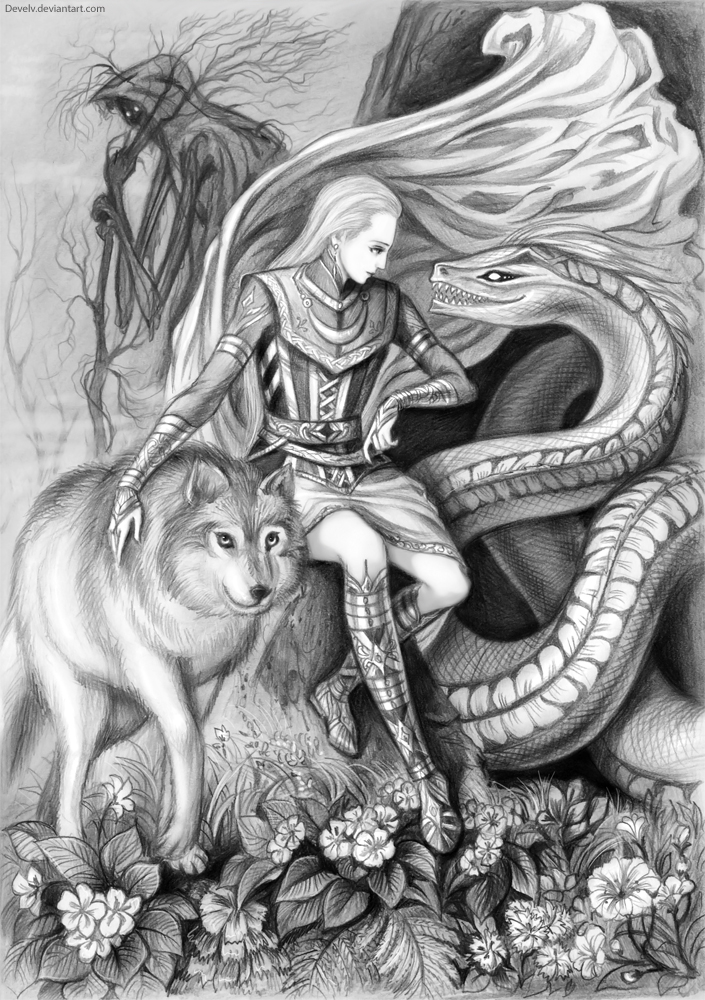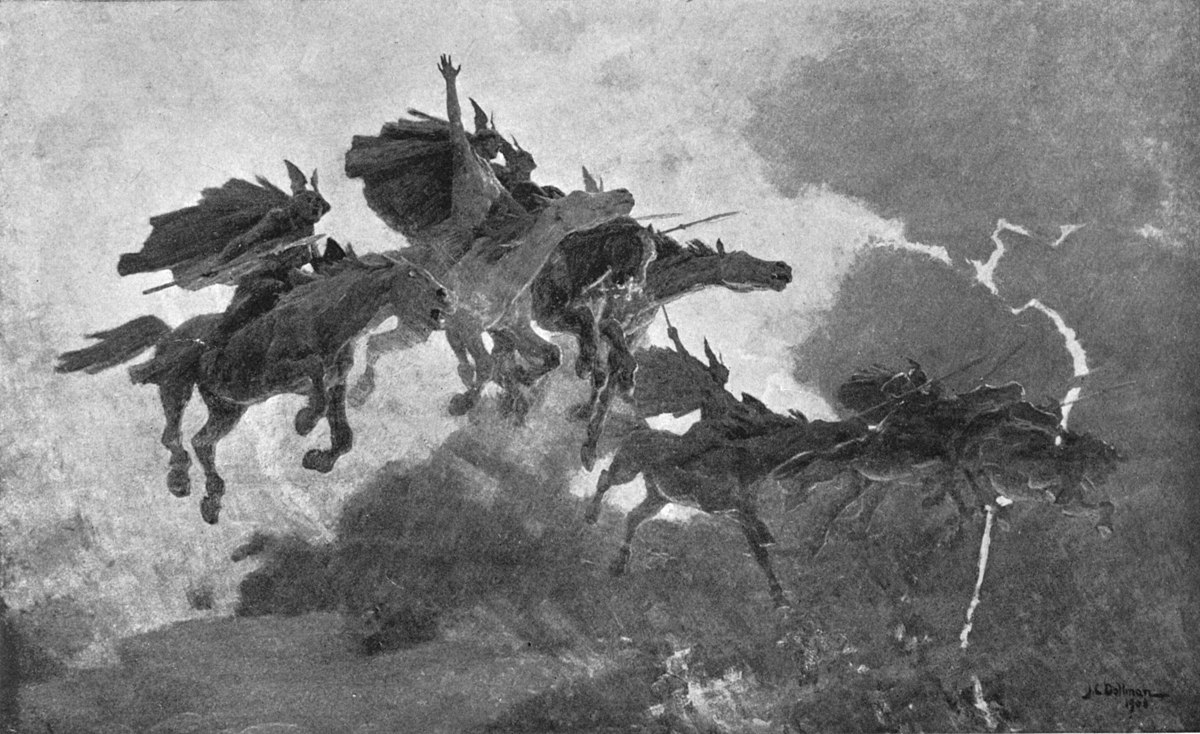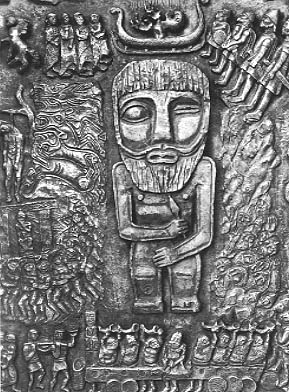Announcements
To any confused students:
With my co-professor's recent retirement, there may be some slightly confusing references to other instructors in the lessons (Professor Morgan). I am slowly beginning the process to ensure that this confusion is mitigated, but it will take some time. All lessons will eventually indicate the correct professor, and credits to the original author will be indicated at the bottom of the lesson itself. Slight modifications will be made in order to make this happen, as some descriptions, personal details, or reasoning will no longer make sense as it pertains to me, but these changes will be minimal and cosmetic.
In the meantime, this is an excellent opportunity to point out any issues of spelling, grammar, or content to me, as I will be going through each lesson individally. I can be contacted via owl.
Lesson 5) Of Trees and Warriors
The students enter Professor Morgan’s classroom and stop in their tracks as they stare at the objects the professor is levitating above them. A large tree with great roots fills the room, light emanating from its core. On its roots are what seem to be giant spheres, but upon closer look are actually worlds, one of ice, one of fire, one dark as night, others too difficult to determine. A plane around the middle of the tree shows familiar scenes to those found in rural areas around the castle, and a shining city grows in the upper branches of the tree. A rainbow appears, joining the city to the plane below.
Professor Morgan holds the items in the air a little longer, then slowly waves her wand, and they settle onto the floor beside her desk. A piece of parchment settles on each desk with a representation of what the students have just observed - a poor comparison, but obviously of significance to the professor.
Take your seats, dear students. Indeed, we have put away our togas, left the Greco-Roman Empire, and travelled north to the home of the Norse people, often referred to as the Vikings. You may use these two terms interchangeably, however I will be referring to the civilization and its people as the Norse.
The image you just saw, and the one represented on the parchment in front of you, is Yggdrasil, the sacred ash tree. Yggdrasil, often times called the world tree, is a visual representation of Nine Worlds, which is the cosmology represented in Norse mythology.
In the roots of the tree lie seven of the Nine Worlds. Their inhabitants are creatures such as the Frost Giants, Elves, Dwarfs, Vanir (older gods), and others we shall hear about in the myths. Midgard is the area represented around the middle of the tree, and that is the world that we all live in. Asgard is the home of the gods, mostly comprised of the Aesir (younger gods), and some Vanir. The rainbow bridge is called Bifrost, and it connects Asgard to Midgard.

As you can see from the map in front of you, the Norse civilization spread out over much of northwestern Europe, especially in the coastal areas. The Norse also settled Iceland and Greenland, and even settled on the eastern shores of Newfoundland in modern day Canada. If you are interested in learning more about this civilization and its history, I suggest you take Ancient Studies, Year Four, if you haven’t already enrolled. For now, we shall turn to the civilization’s mythology.
Norse Pantheon
Have a look at the charts below for a better understanding of the relationships between the Norse gods:

Selected sections of the Norse Pantheon
Similar to the Greco-Roman pantheon, the Norse pantheon was made up of groups of older and younger gods who warred with each other. In this case, the Vanir were the older gods, who were associated with fertility, wealth and good weather. The Aesir were the younger gods who were all connected with some aspect of warfare. Dissimilar to the Greco-Roman pantheon, neither of these two groups of gods was descended from each other; they were essentially two different races.
The conflict between these two divine races ended when both sides were exhausted, and agreed to live at peace with each other. Due to the terms of their peace, some of the Vanir went to live in Asgard with the Aesir, the most famous of which are Freyr and Freyja. These two Vanir were twins who were bestowed with magical powers. Freyja was the goddess of love, and Freyr the god of fertility.

Odin, the Allfather and leader of the Aesir
The Aesir were led by Odin (sometimes known as Woden or Wotan), also referred to as the Allfather, as he was indeed the father or grandfather of these gods. He himself was descended from giants. From Odin and either his wife or one of his mistresses, came the other gods. Most of these offspring were heroes and warriors, such as Thor and Tyr, and others were known for their goodness, such as Balder.
One more rather important character to note, although he was not technically a god, was Loki. While raised in Asgard, Loki was actually the child of giants, and a great trickster. If something went wrong in a myth, Loki or one of his own offspring was involved. Loki’s offspring consisted of the great wolf, Fenrir; Jormungandr, the Midgard Serpent; Hel, the goddess of death, who ruled the realm of the same name; and, although missing from our chart above, Sleipnir, the eight legged horse ridden by Odin.

Before we delve deeper into these characters and their stories, I would like to point out one very significant difference between the Norse gods and other pantheons you may have studied. The Norse gods were not immortal. They could die, and indeed most were destined to do so at the end of the world, which we will discuss in our next class. Do keep that in mind as we continue, as it makes their acts of bravery and defiance much more significant.
The Valkyries
Odin was, at his core, a lover of knowledge and battle. In battle, he had a group of handmaidens to aid him. Named the Valkyrie, literally female choosers of the slain, they were depicted in earlier myths as demons, or at the very least great warriors riding dragons and horses. They collected up the souls of the bravest heroes who had fallen in battle, and bore them to Valhalla, the heavenly abode of Odin’s army, located in Asgard. In later myths, the Valkyrie are portrayed as swan maidens who were fierce in battle, yet vulnerable to falling in love with mortal heroes.

The interesting point to note about the Valkyrie are actually their mounts. Whether they rode dragons or winged horses, they were regardless using magical beasts, which means their myth may have some basis in fact. Perhaps they rode Thestrals as certainly everyone in a battle would have witnessed death. These creatures would have terrified anyone who had never seen them before. If they indeed rode dragons, well, you can imagine the sheer terror that would have overcome the battlefield.
Norse Heroes
Odin
We have spoken a bit about Odin already, however in some ways he is also a hero. It is not his feats of heroism or battles with monsters (although there are several examples of those) that give him his heroic status, but his great quests for knowledge instead.
Odin was certainly a god of war, but also considered a god of magic and wisdom. In fact, Odin twice sacrificed himself to achieve greater wisdom and understanding to satisfy his love of knowledge. Firstly, he sacrificed one of his eyes by cutting it out and threw it into a magical well in return of a drink of immense wisdom. Secondly, he hung himself for nine days on Yggdrasil in order to die and be reborn by magic. This resurrection gave him greater wisdom than anyone else.

One-eyed Odin. Bronze relief c. 1950
With great knowledge, however, came great and eternal despair for Odin. He knew exactly how the end of the world (known as Ragnarok) would occur, and that the death of one of his sons would signal the beginning of this. He new Ragnarok would be the end of almost all of the gods as they were destined to die during this epic final battle. Even with this knowledge, Odin continued to rule the gods and taught battle skills and theory to various kings. I believe it takes a great amount of strength to carry on knowing the worst is coming, and that is what makes Odin a hero.
Thor
Perhaps one of the most famous of the Norse heroes was Thor, Odin’s son by a giantess. Thor was the god of thunder, and, along with his great hammer Mjolnir, was unstoppable in battle. It was his purpose to destroy the enemies of the gods, the Frost Giants. Along with Loki, who was his friend at the time, he had many adventures and slew a great number of enemies.

One of the most amusing stories of Thor is when his hammer was stolen by Dwarves and given to a Frost Giant named Thrym. Thrym demanded marriage to the goddess Freyja as the price to return Mjolnir to Thor.
Since leaving such a powerful weapon in the hands of their enemies was just as bad as handing over the goddess, Loki devised a plan to trick Thrym. Thor, dressed as a woman, was able to trick Thrym into thinking that Freyja had accepted his proposal. Thrym let down his guard and place Mjolnir at Thor’s feet. Needless to say Thor ceased being a coy bride at that moment and wrought his revenge on the Frost Giants before taking Mjolnir home to Asgard.
Beowulf
The myth of Beowulf is considered by scholars to be the greatest known Old English epic poem. It is certainly the oldest surviving poem. The oldest copy of the myth is called the Nowell Codex, and is currently housed in the Muggle British Library. The manuscript itself was written somewhere between 975 and 1010 C.E., however most scholars agree that historically accurate details contained in the myth indicate that it was originally composed closer to 700 C.E.
Nowell Codex - slightly singed - British Library
The story took place in modern-day Denmark, where the hall of King Hrothgar (an actual Danish king) was being accosted by a monster named Grendel. In the middle of the night, Grendel, who was apparently disturbed by the raucous noise of the mead hall, snuck in, snatched up a warrior, and ate or maimed him. After several instances of this horror, Beowulf arrived from a neighbouring kingdom to assist.
Beowulf pretended to be asleep in the hall the evening of his arrival, and after Grendel grabbed and killed one of the other warriors, he grabbed Beowulf, who was ready for a fight. Using his hands, for weapons seemed useless on the creatures, Beowulf managed to rip off Grendel’s arm. Mortally wounded, Grendel fled from the hall.
Thinking this the end of the problem, King Hrothgar showered Beowulf with gifts and the warriors once again revelled into the night, and then collapsed and slept in the hall. What they did not realize was that Grendel had fled to his mother’s cave, whereupon he died.
Grendel’s mother, whose proper name is never given, was just as vicious as her son, but also intelligent. Infuriated by the death of her son, she stole into the hall and ate another warrior. Beowulf followed her back to her partially submerged lair and another great battle took place. Only the timely discovery of a magical sword in the water of the cave allows Beowulf to prevail.
After defeating Grendel’s mother, Beowulf returned home to the southern part of modern-day Sweden where he ruled for many years. At the end of his reign, Beowulf was once again tested in battle, but this time against a dragon who was attacking his land. Beowulf triumphed again over the beast, however he was mortally wounded during the battle, living only long enough to see his people claim the dragon’s treasure for their own.
While certainly a thrilling tale, which I’ve barely given justice to in my retelling, it is the creatures mentioned in this epic poem that are most interesting from a magical standpoint. Let’s examine the description of Grendel; a large creature, very strong, not overly intelligent, and lives in a cave partially submerged in water. We also have a description of his mother as a violent female protecting her son, but not the same as him. The translations from the original text describing the mother indicate that she is a monstrous woman, but not necessarily a monster, and that she also had use of magic. Upon conferring with several professors at Hogwarts, I believe it is safe to say that Grendel’s mother is a human and a witch, and Grendel himself is a half-breed river troll. It does indeed sound like an unusual pairing, however I have been assured that it is possible!
Sigurd
A Norse hero who was most famous in the area of modern day Iceland, Sigurd (or Siegfried, as he is called in German) is known for slaying the dragon, Fafnir. Sigurd was a fosterling raised by Regin, the smith at the court of Jutland. He was charged by the king of Jutland to retrieve the hoard of the dragon. Unbeknownst to Sigurd, Fafnir was actually Regin’s brother. The two brothers had previously stolen the hoard from a Dwarf, and Fafnir had turned into a dragon to guard it.

Sigurd was quite ingenious, and hid inside a hole in Fafnir’s regularly used track. As the dragon crawled across the path, Sigurd slit his belly, killing him. The blood of the dragon was magical, however, and bestowed upon Sigurd both the ability to speak to birds, as well as the wisdom of the dwarves. It was this wisdom that allowed him to realise that Regin intended to kill him for the hoard, and instead it was Sigurd who killed Regin.
Alas, many of the Norse heroic tales do not have happy endings. Sigurd spent the rest of his life cursed by the treasure he had secured for the king - something we will discuss further next class - however, it demonstrates an example of what we know as magic use in the myth. Cursed treasure does exist, and this myth may easily be a warning to avoid stealing treasure from others. It also demonstrates knowledge of an animagus, or possibly transfiguration, as Fafnir turned himself into a dragon. Clearly, aspects of our magical heritage are present in these myths.
There are a great many other Norse heroes. Some of them we will discuss next class, and some of them I will leave for you to discover on your own as part of an assignment you will complete when we finish our discussions on the Norse.
To finish off today you will have a quiz on the content we have just covered, and, of course, you will be writing your midterm. You didn’t think I had forgotten, did you? Your midterm will consist of a number of short answer questions on the material we covered in Lessons One through Four. Best of luck, and see you next class!

________________________________________________
Sources:
Cotterell, Arthur & Storm, Rachel. 1999. The Ultimate Encyclopedia of Mythology. Hermes House Anness Publishing Ltd. New York.
Grimal, Pierre. Ed. 1989. Larousse World Mythology. Gallery Books, New York.
- MYTH-401
Enroll



